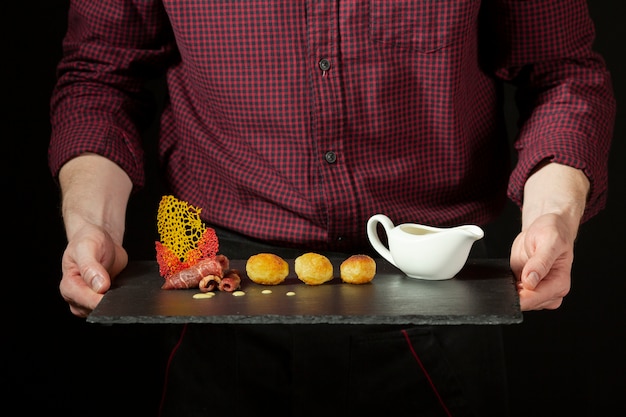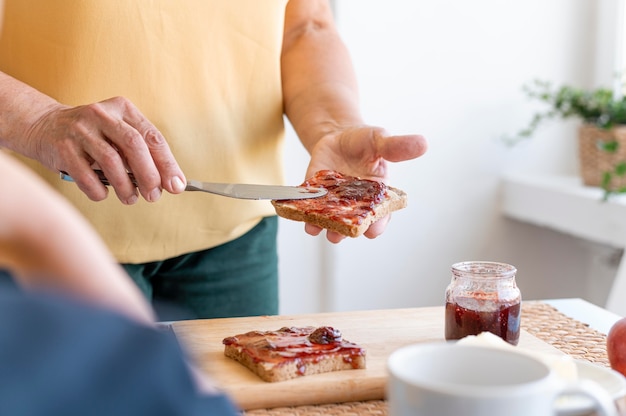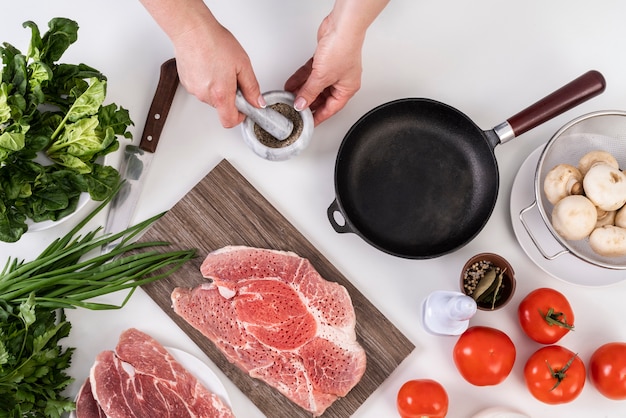Ah, beef. The very word conjures up images of sizzling steaks, hearty roasts, and mouthwatering burgers. It's a culinary staple that holds a special place in my heart. Over the years, I've learned a thing or two about cooking beef, from avoiding those dreaded dry, tough pieces to crafting a meal that's truly unforgettable. Now, I'm ready to share all my secrets, tips, and tricks with you. This is your comprehensive guide to cooking delicious beef, packed with information on choosing the right cuts, mastering different cooking techniques, and even understanding the finer points of beef grading. Let's dive in!
(Part 1) Choosing the Perfect Cut: A Journey Through the Butcher's Showcase

Choosing the right cut of beef is the foundation of a great dish. It's like picking the right fabric for a dress—you need the right starting point to create something beautiful. The world of beef cuts is vast and exciting, and each cut boasts a unique personality, texture, and suitability for different cooking methods. Let's explore the highlights:
Steaks: The Stars of the Beef World
Ah, steaks. These are the heartthrobs of the beef world. They're perfect for grilling, pan-frying, and even slow-cooking. Here are some of the most popular steak choices:
- Ribeye: A true champion of flavour, the ribeye is known for its generous marbling, making it melt-in-your-mouth tender and bursting with juicy flavour. It's the perfect choice for a luxurious experience, especially when grilled or pan-fried. Remember, this cut is quite thick, so plan accordingly.
- new york strip: This steak offers a wonderful balance of marbling and leanness, resulting in a beautifully tender and flavorful experience. It has a larger surface area than the ribeye, making it ideal for those delicious grill marks. The New York Strip is a true crowd-pleaser, especially when cooked to medium-rare.
- filet mignon: This is the ultimate indulgence, the crème de la crème of steaks. It's the most tender and delicate cut, known for its leanness and buttery texture. Its delicate nature means it's best cooked quickly to avoid dryness. A perfectly seared filet mignon with a rich sauce is a true culinary masterpiece.
- Sirloin: A reliable and affordable choice, the sirloin steak is a great option for those looking for a balance of flavour and tenderness. It's leaner than the ribeye and New York Strip but still offers a delicious, juicy bite. The sirloin is versatile, perfectly suited for grilling, pan-frying, or even adding to a classic steak recipe.
- skirt steak: This is a thin, flavorful cut of beef that's known for its rich taste. It's best suited for quick cooking methods like grilling or pan-frying, and its inherent toughness becomes a thing of the past when marinated and cooked properly. Skirt steak is a popular choice for fajitas and other Mexican-inspired dishes, adding a delicious smoky flavour and tender texture.
- flank steak: This is a lean, flavorful cut that's ideal for those who enjoy bold flavors. It's perfect for marinating, as it absorbs the flavours beautifully. It's best cooked quickly, whether it's grilling, pan-frying, or even using a high heat in the oven. Think of delicious beef sandwiches, stir-fries, or sliced thinly for a delightful salad topper.
Roasts: The Showstoppers of the Dinner Table
Roasts are the stars of any special occasion or family gathering. They're slow-cooked to achieve a tenderness and depth of flavour that's hard to resist. Here are some of the most popular roast choices:
- prime rib: A true king among roasts, prime rib is a thick, marbled cut of beef that's perfect for slow roasting. It's unbelievably flavorful and tender, making it a crowd-pleaser at any event.
- Standing rib roast: A beautiful and impressive presentation, the standing rib roast is a cut of prime rib that has been left intact, creating a visually stunning centerpiece for your table. It's a perfect choice for a special occasion, guaranteed to impress your guests.
- Top sirloin roast: This is a leaner roast option, yet it doesn't compromise on flavour or tenderness. It's a great choice for those looking for a healthier alternative to the more marbled roasts. The top sirloin roast can be roasted, grilled, or even slow-cooked to perfection.
- chuck roast: This is a tough but flavorful cut that shines when slow-cooked. It's packed with flavour and becomes remarkably tender when cooked low and slow. Think of hearty pot roasts, beef stew, or delicious pulled beef sandwiches.
ground beef: The Versatile All-Rounder
Ground beef is a versatile ingredient that can be transformed into countless dishes. It’s perfect for burgers, meatballs, tacos, chili, and even the base for hearty sauces. When choosing ground beef, look for a higher fat content. This will result in a juicier and more flavorful dish. Don’t be afraid of the fat—it’s what gives ground beef its wonderful richness.
(Part 2) Understanding the Different Beef Grades: A Guide to Quality

Now that you've chosen your cut, let's delve into the world of beef grades. These grades are a system for classifying beef based on its quality, including marbling, tenderness, and overall flavor.
In the UK, we don't have the same grading system as the US. Instead, we have a "Beef Quality Assurance" scheme, which ensures all beef sold in the UK meets certain standards. However, you'll still find labels on meat packaging that offer some insight into the quality. Look out for these designations:
- "Prime" or "Premium": This signifies the highest grade, typically indicating a good amount of marbling, resulting in a very tender and flavorful cut.
- "Standard": This indicates good quality beef that's generally affordable and suitable for most recipes.
- "Select": This signifies a leaner cut of beef with less marbling, but it's still tender and flavorful.
If you're unsure, don't hesitate to ask your butcher for advice. They’re experts in beef and can guide you to the perfect cut for your needs.
(Part 3) Preparing Your Beef: A Few Simple Steps for Success

You’ve got your perfect cut, you’ve considered the grade, now it’s time to prepare your beef. This stage is crucial for achieving the best flavour and texture. Let's break it down:
1. Trim the Fat: A Balancing Act
Trim off any excess fat, but remember, don't remove all of it! The fat adds flavour and keeps the meat moist during cooking. Just trim off any large chunks or pieces of fat that seem excessive.
2. Pat Dry: Ensuring a perfect sear
Pat the beef dry with paper towels. This will help ensure a good sear and prevent the meat from steaming instead of browning. A good sear adds depth of flavour and a lovely crust. It’s all about getting that beautiful browning and delicious crust!
3. Season: Bringing Out the Natural Flavors
Season your beef generously with salt and pepper. You can also add other seasonings, such as garlic powder, onion powder, paprika, or chili powder. Seasoning is key to bringing out the natural flavors of the beef. Don't be afraid to experiment with different spices! I like to add a pinch of smoked paprika to my steaks for a hint of smokiness.
4. Marinate: Adding Depth of Flavor (Optional)
Marinating your beef is a great way to add extra flavour and tenderness. You can use a simple marinade of olive oil, lemon juice, and herbs, or get creative with a more complex blend of ingredients. If you're marinating, make sure to do it for at least 30 minutes, but preferably for a few hours, or even overnight.
(Part 4) Mastering the Art of Cooking Beef: A Guide to Different Techniques
Now for the exciting part—cooking the beef! There are many different ways to cook beef, each with its own unique results. Let's explore the most common techniques:
1. Grilling: The Classic Approach
Grilling is the classic way to cook beef. It's perfect for steaks, burgers, and other thicker cuts of meat. For a great grill, make sure your grill is nice and hot. This will ensure a good sear and even cooking. Don't forget to brush the grates with oil to prevent the meat from sticking.
- Direct Grilling: This involves cooking the beef directly over the heat source. It's perfect for steaks and burgers, and it gives the meat a delicious smoky flavour.
- Indirect Grilling: This involves cooking the beef over indirect heat. It's perfect for larger roasts, as it allows the meat to cook slowly and evenly.
2. Pan-Frying: Achieving a Crispy Crust
Pan-frying is a great way to cook smaller cuts of beef, like steaks and burgers. Use a heavy-bottomed pan that will heat evenly and prevent the meat from sticking. Heat the pan over medium-high heat before adding the beef. Don’t overcrowd the pan; cook in batches if needed to ensure even browning.
3. slow cooking: Transforming Tough Cuts
Slow cooking is a great way to cook tougher cuts of beef, like chuck roast. It involves cooking the meat over low heat for a long period of time, which breaks down the tough muscle fibers and results in tender, flavorful meat. I recommend using a slow cooker for this, but you can also slow cook in the oven.
4. Roasting: Creating a Tender and Juicy Center
Roasting is perfect for larger cuts of beef, like prime rib. It involves cooking the meat in a preheated oven, which results in a tender, juicy roast. I prefer to roast my beef at a low temperature (around 325°F) for a longer period of time, which ensures even cooking and prevents the meat from drying out.
5. Broiling: Achieving a Quick and Crisp Finish
Broiling is similar to roasting, but the heat comes from above, rather than from below. It's perfect for steaks, burgers, and other small cuts of beef. Keep a close eye on the meat, as it can cook quickly!
(Part 5) Knowing When Your Beef is Cooked to Perfection: A Guide to Doneness
We've chosen our cut, prepped our beef, and selected our cooking method. Now, how do we know when it's ready? The goal is to achieve a perfectly cooked piece of beef, with a juicy interior and a delicious crust. Here's how to determine doneness:
1. Using a meat thermometer: The Scientific Approach
The most reliable way to determine doneness is to use a meat thermometer. Insert the thermometer into the thickest part of the meat, avoiding any bone. Here's a chart showing the internal temperatures for different levels of doneness:
| Doneness | Internal Temperature (°F) | Internal Temperature (°C) |
|---|---|---|
| Rare | 125-130 | 52-54 |
| Medium-Rare | 130-135 | 54-57 |
| Medium | 140-145 | 60-63 |
| Medium-Well | 150-155 | 65-68 |
| Well-Done | 160 | 71 |
2. The Touch Test: A Hands-On Approach
If you don’t have a thermometer, you can use the touch test to gauge doneness. Press your finger against the meat. The texture will feel similar to the level of doneness you’re aiming for. For example, rare meat will feel soft, while well-done meat will feel firm.
3. The Color Test: A Visual Cue
You can also judge doneness by looking at the color of the meat. Rare meat will be red in the center, medium-rare meat will have a pink center, and well-done meat will be brown throughout.
Remember, these are just general guidelines. The best way to determine doneness is to experiment and find what you enjoy the most. I’m a big fan of medium-rare, but I know plenty of people who prefer their beef well-done. There’s no right or wrong answer here, it’s all about your personal taste.
(Part 6) Resting Your Beef: A Crucial Step for Juiciness
Once your beef is cooked, it's important to let it rest before slicing and serving. This allows the juices to redistribute throughout the meat, resulting in a juicier and more flavorful steak.
Cover the beef loosely with foil and let it rest for at least 5-10 minutes. For larger cuts of meat, rest for 15-20 minutes. You can use this time to prepare your sides.
(Part 7) Slicing and Serving: The Grand Finale
Now for the moment of truth, it's time to slice and serve your beef!
1. Slicing Against the Grain: Unlocking Tenderness
For steaks and other cuts of beef, slice the meat against the grain. This will make the meat easier to chew and more tender. The grain refers to the direction of the muscle fibers. You can easily identify the grain by looking at the cut. Slice perpendicular to the grain.
2. Serving with Sides: Completing the Culinary Symphony
Beef pairs well with a variety of sides, depending on the cut and the cooking method. Here are some classic pairings:
- Steaks: mashed potatoes, asparagus, roasted vegetables, salad
- Roasts: Yorkshire pudding, roast potatoes, gravy, vegetables
- Ground Beef: Rice, beans, tortillas
3. Adding a Sauce: Elevating the Flavor Profile (Optional)
Adding a sauce to your beef can elevate it to new heights. You can use a classic sauce like béarnaise or a simple pan sauce made from the drippings in the pan.
(Part 8) Leftovers and Storage: Making the Most of Every Bite
Leftover beef is a real treat! It can be used in sandwiches, salads, or even for a quick stir-fry. To store leftover beef, simply wrap it tightly in plastic wrap or aluminum foil and refrigerate it for up to 3-4 days. You can also freeze leftover beef for up to 3 months.
FAQs: Answering Your Most Pressing Beef-Related Questions
Now, let’s address some common questions about cooking beef:
1. Can I reuse marinade on cooked beef?
It’s not recommended to reuse marinade on cooked beef. Marinades are often raw and could contain bacteria that can cause food poisoning. If you want to use the marinade as a sauce, bring it to a boil for at least 1 minute to kill any bacteria.
2. How can I make my beef more tender?
There are a few ways to make beef more tender:
- Use a tender cut of beef: Choose cuts that are naturally tender, like ribeye or filet mignon.
- Marinate the beef: This helps to break down the muscle fibers and make the meat more tender.
- Slow cook the beef: This also helps to break down the muscle fibers and make the meat more tender.
- Use a meat tenderizer: A meat tenderizer can help to break down the muscle fibers and make the meat more tender.
3. What’s the best way to cook a tough cut of beef?
Tough cuts of beef are best cooked using a slow cooking method, like braising or slow cooking. This will break down the tough muscle fibers and result in tender, flavorful meat.
4. What’s the difference between “grass-fed” and “grain-fed” beef?
Grass-fed beef comes from cows that have been fed a diet of grass, while grain-fed beef comes from cows that have been fed a diet of grain. Grass-fed beef is generally leaner and has a more intense flavor. Grain-fed beef is often more marbled and has a more buttery flavor. The choice is ultimately yours, based on your personal preferences and dietary needs.
5. How do I know if my beef is spoiled?
Spoiled beef will have a sour or rancid smell, and it may also have a slimy texture. If you’re unsure, it’s best to err on the side of caution and discard the meat.
And there you have it—your complete guide to cooking delicious beef! I hope you found these tips helpful. Remember, cooking beef is all about experimentation. Try different cuts, cooking methods, and seasonings to find what you enjoy the most. Happy cooking!
Everyone is watching

Prime Rib Roast Cooking Time Chart: Per Pound Guide
Cooking TipsPrime rib roast. Just the name conjures images of lavish dinners, crackling fires, and hearty laughter. It’s ...

How Long to Bake Potatoes in the Oven (Perfect Every Time)
Cooking TipsBaked potatoes are a staple in my kitchen. They're incredibly versatile, delicious, and surprisingly easy to m...

Perfect Rice Every Time: The Ultimate Guide to Cooking Rice
Cooking TipsAs a self-proclaimed foodie, I've always been a bit obsessed with rice. It's the foundation of countless cuisi...

The Ultimate Guide to Cooking Asparagus: Tips, Techniques, and Recipes
Cooking TipsAsparagus. The mere mention of this spring delicacy conjures up images of vibrant green spears, crisp and burs...

Ultimate Guide to Cooking the Perfect Thanksgiving Turkey
Cooking TipsThanksgiving. Just the word conjures up images of overflowing tables laden with delicious food, the scent of r...
